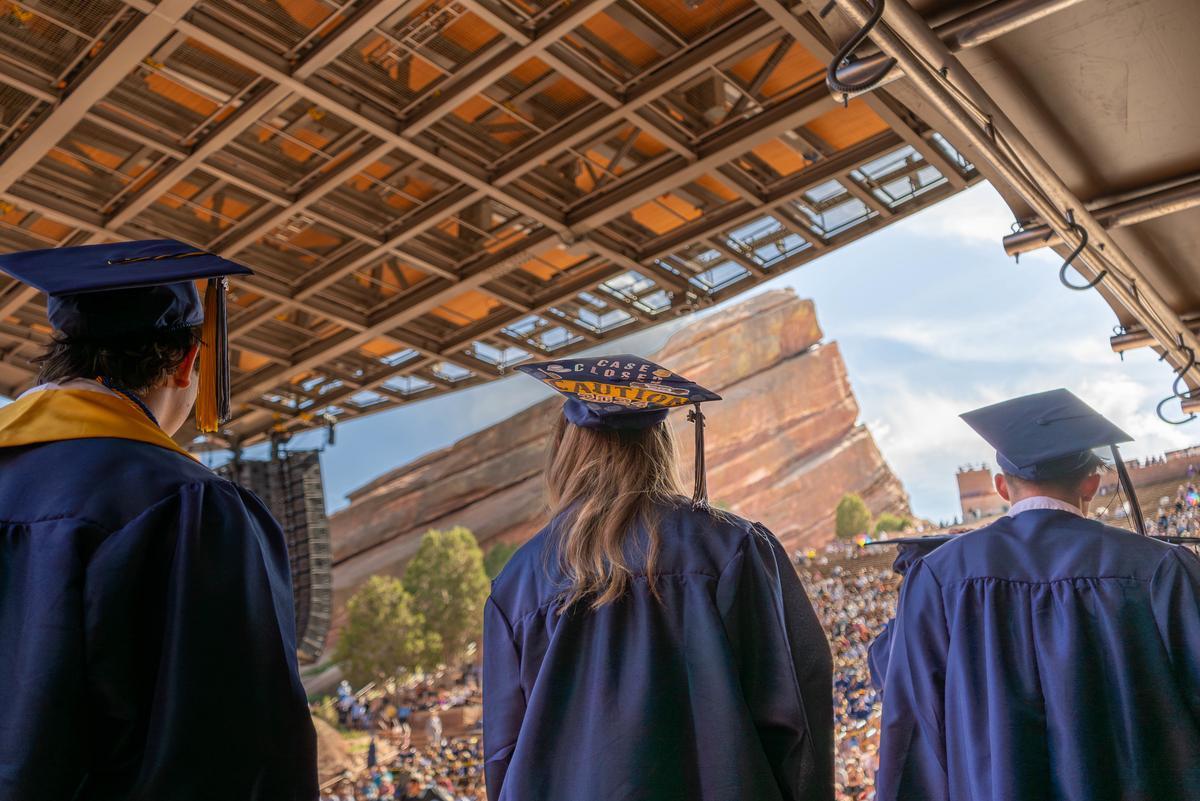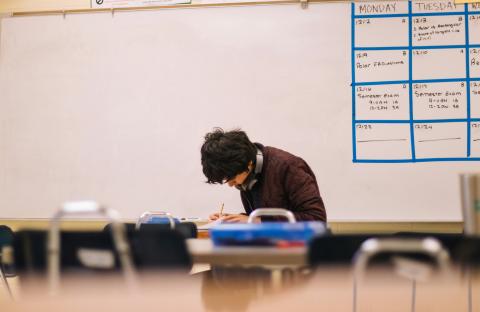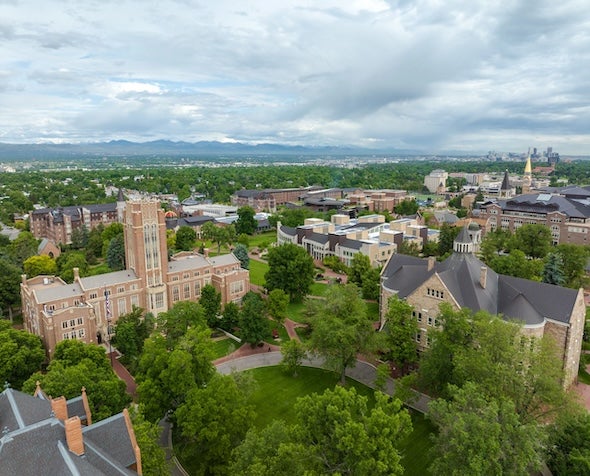‘I Feel like a Typical Student’: How DU’s Colorado Lab Is Revolutionizing Educational Attainment for Students in Foster Care
From pilot program to full-scale success story, Fostering Opportunities provides stability and pathways to a brighter future for vulnerable youth.

Credit: Jeffco Public Schools
Only 30% of Colorado’s students in foster care will graduate alongside their peers this commencement season. What’s supposed to be launching pad for youth is often a missed milestone for those in and out of the foster care system.
“We couldn’t turn a blind eye to it,” says Addi Cantor of Jeffco Public Schools, who knows all too well the challenges for these students, following a decade of work in child welfare programming.
Students in foster care are precariously situated in the K-12 landscape. Instability in a student’s caretaking situation, home address, school or even district disrupts the consistent supportive structures crucial to a student’s academic and social-emotional success.
“These are students who at any time, without warning, could be moved or asked to change schools or put into a different community,” says Cantor.
But a presentation from Elysia Versen, then a faculty member at the University of Northern Colorado and now the deputy director and chief operating officer at DU’s Colorado Lab, offered Cantor a solution she could get behind.
Versen, along with state agency and philanthropy partners, proposed completely re-structuring support by better aligning social welfare and educational institutions and placing specialists within the schools to build personalized relationships with students.
The result was a multi-year partnership between Colorado Lab and Jeffco Public Schools called Fostering Opportunities, a program that researchers and practitioners say is a remarkable success story, praising its innovative funding model, evidence-based programming and, most significantly, its tangible impact on the daily lives of students.
“Our greatest successes have been when a student can look at us and say, ‘I feel like a typical high school student’,” says Cantor.
Coordinating support—and proving it works
The key difference between Fostering Opportunities and existing support for students in foster care is that educational agencies lead interventions, rather than child welfare or judicial systems. Education leading the intervention ensures continuity of service after a child returns home or is adopted and their child welfare case closes. This continuity is important because research indicates that students need services for the duration of their schooling experience.
“Just because their child welfare case closes, or they're reunified with their families and the student is safe to live at home, doesn't mean that their academics are stabilized and they're doing really well in school,” says Versen. “We wanted to essentially bridge that gap and ensure that the student remains eligible for this program as long as they need it.”
Finding a research-backed solution is one thing, but funding it is another challenge. As Colorado’s first-ever Pay for Success project, the program was co-funded by the State of Colorado and the Community First Foundation (now the Colorado Gives Foundation) as a pilot in Jeffco Public Schools in 2019. The evaluation was led by Colorado Lab through a randomized controlled trial which deemed the program successful, prompting the State to reimburse the Colorado Gives Foundation for their initial investment.
Fostering Opportunities dissolves barriers between child welfare, schools and other youth-serving agencies through increased lines of communication and data sharing agreements.
“It's multiple pieces of a puzzle. Data-informed policies and evidence-based practices—both of those things need to come together to close the gap, and they have in Colorado,” says Versen.
Students are also assigned a specialist who provides individualized attention through advocacy, mentorship and social-emotional support. Specialists meet students at their school, making meetings accessible and flexible, even if a student moves to a different home.
“They know that we're trusted humans; we're not here to take them to court or change their life in any way other than (being) supportive,” says Cantor. “They feel like they can lean on us when they need guidance.”
In the randomized controlled trial, 230 students were split into two groups—half in a Fostering Opportunities “treatment” group and half in a “control” group The results were encouraging. Colorado Lab demonstrated that Fostering Opportunities improved attendance, reduced behavioral incidents and improved pass rates for the classes. Descriptive results from a report published in February this past year suggest that within one year, there was a 50.49% increase in the number of students who were on track to graduate.
“That tells us that it's a program that's scalable, and that it's driving the outcomes that we expect,” says Versen.
The program in Jeffco is now sustained through Colorado’s Foster Care Success Act (House Bill 22-1374), which also provides funding for Denver Public Schools and 27J Schools to implement the program. The $1.1 million required to sustain the program annually constitutes a modest investment for the state, particularly when juxtaposed with the potential lifetime costs stemming from negative outcomes for youth aging out of the foster care system, such as incarceration, early parenthood or homelessness. These costs, resulting from just one year's cohort, can soar up to $73 million.
Powered by relationships
At the heart of Fostering Opportunities is the belief that relationships are the key to student success.
“We focus on our students building their social capital network, so that they always have someone they can go to for whatever need they might have,” says Cantor.
Stable relationships with caregivers, specialists and other adults create what researchers call “network closure,” meaning that all supports in a student’s life are interconnected, aware of each other’s actions and coordinated in their interventions.
Megan Rhoades is a coordinator with 27J schools and applied to bring Fostering Opportunities to her district in the 2023-24 school year. With the leadership and support of Rachel Muniz, a support specialist, the program has already made significant strides towards network closure.
“There's been multiple instances this year where if it weren't for Rachel and the relationship she has with kids, foster parents and caseworkers, kids would have been lost,” says Rhoades.
While students in traditional family settings have parents to help navigate the transition to adulthood, students in foster care are often at a disadvantage, says Muniz. In addition to supporting students’ social-emotional health or problems with teachers, Muniz also helps them with things like filling out financial aid forms or locating their social security number. She’s someone who is always “in their corner,” she says—to the extent that students are often excited to see her.
Fostering Opportunities provides a model for how to best serve all students, not just those in foster care, says Muniz and Rhoades.
“My big dream would be that the supports that are offered through [Fostering Opportunities] bleed into the other social-emotional work and becomes the norm—that [every student] has a trusted adult,” says Rhoades.
The future is bright
The long-term goal of professionals working with youth in the foster system is to help students become confident self-advocates.
“Whether that means being able to speak up in their foster home or approaching a teacher about make-up work or a court date—the last thing we want is to send our students out to the world feeling alone or not knowing how to reach people,” says Cantor.
For Versen, the hope is that Fostering Opportunities continues to scale throughout Colorado with the evaluative backing of Colorado Lab. In the 2023-24 school year, more than 200 students were a part of the program, and the numbers will only grow. Having done presentations in Ohio and California, she says the program is already commanding attention nationally. It’s also galvanizing workers in the foster care space to hope for a better future, one in which the number of foster youth walking across the graduation stage each spring continues to rise.
“My dreams of the future are really unfolding before me as other districts are implementing the program,” says Cantor. “The number one goal is 100% of students who have ever experienced foster care are completing high school.”













